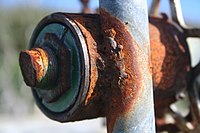
Photo from wikipedia
Abstract Our previous particle-resolved simulation study has elucidated that the conversion of coal char particle at analogous chemical looping with oxygen uncoupling conditions (a relatively low temperature, e.g., 900 °C, and… Click to show full abstract
Abstract Our previous particle-resolved simulation study has elucidated that the conversion of coal char particle at analogous chemical looping with oxygen uncoupling conditions (a relatively low temperature, e.g., 900 °C, and relatively low O2 concentration but relatively high CO2 concentration, e.g., 1 vol% O2 + 99 vol% CO2) is characterized by that the oxidation reaction happens peripherally while the gasification reaction happens inside the char particle; the total conversion rate of the particle can be modeled as the sum of the full oxidation conversion rate rox and the partial gasification conversion rate φrgasi, i.e. r = rox + φrgasi. In this work, based on the previous conclusions and under the framework of the Smith's model, a modified intrinsic model is proposed in order to simulate the conversion rate of char particle in typical chemical looping with oxygen uncoupling conditions more accurately. The main point of the proposed model is to determine the position of the interface between the oxidation region and the gasification region by the criterion that the local gasification rate is equal to the local oxidation rate. The accuracy of the modified intrinsic model is validated by comparing the model predictions with the particle-resolved simulation results. Using the modified intrinsic model, the conversion processes of char particles under different conditions are analyzed. The differences between the proposed model and the conventional models, which either consider the oxidation only or consider the oxidation and gasification contributions independently, are also analyzed.
Journal Title: Fuel
Year Published: 2020
Link to full text (if available)
Share on Social Media: Sign Up to like & get
recommendations!